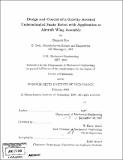| dc.contributor.advisor | H. Harry Asada. | en_US |
| dc.contributor.author | Roy, Binayak, 1979- | en_US |
| dc.contributor.other | Massachusetts Institute of Technology. Dept. of Mechanical Engineering. | en_US |
| dc.date.accessioned | 2008-11-07T19:07:26Z | |
| dc.date.available | 2008-11-07T19:07:26Z | |
| dc.date.copyright | 2008 | en_US |
| dc.date.issued | 2008 | en_US |
| dc.identifier.uri | http://hdl.handle.net/1721.1/43140 | |
| dc.description | Thesis (Ph. D.)--Massachusetts Institute of Technology, Dept. of Mechanical Engineering, 2008. | en_US |
| dc.description | Includes bibliographical references (p. 108-111). | en_US |
| dc.description.abstract | We present the design and control of a hyper-articulated robot arm comprising just a few active joints driving a multitude of passive joints. This underactuated arm design was motivated by the need for a compact snake-like robot for assembly operations inside an aircraft wing. The interior of the wing is accessible only through small access portholes distributed along the length. Currently, such assembly operations are performed by human operators who crawl into the wing through its access portholes. The working conditions are ergonomically challenging and result in frequent injuries. The conflicting requirements of small form factor and high payload carrying capacity have been the primary bottlenecks in the development of assembly robots. We propose a nested-channel serial linkage structure for the hyper-articulated arm. When fully contracted, the arm is extremely compact and can access the interior of the wing through its access porthole. Once inside the wing, the arm may be expanded to access distal assembly locations. However, it is impossible to package current actuator technology to meet the payload requirements within the limited size of the robot arm. The joints of the hyper-articulated arm have no dedicated actuators. Instead, they are deployed by modulating gravitational torques. By tilting the base link appropriately, the gravitational torque drives each unactuated link to a desired angular position. With simple, compact locking mechanisms, the arm can change its configuration using the actuated base placed outside the wing. We analyze the system dynamics to gain physical insight into the interaction between the actuated and unactuated degrees of freedom. We make important approximations to capture the dominant effects in the system dynamics so as to facilitate control design. | en_US |
| dc.description.abstract | (cont.) The dynamics (actual, as well as approximate) of the unactuated links are essentially 2nd order non-holonomic constraints, for which there are no general control techniques. We present several motion planning algorithms for sequential positioning of the free joints of the robot arm. The motion planning algorithms are formulated as parameterized non-linear two point boundary value problems. These algorithms demonstrate reasonable performance in the absence of disturbances. However, the end-effecter requires accurate positioning to perform assembly operations. To address this issue, we present a sequential closed-loop control algorithm for accurate positioning of the free joints. We synthesize a Lyapunov function to prove the convergence of this control scheme and to generate estimates of the domain of convergence. For faster deployment of the robot arm, multiple free links must move concurrently. We also present several motion planning algorithms to address this problem. We built two prototypes to illustrate the design and actuation concepts. The first prototype has 3 links and has a fixed axis of tilt in the horizontal plane. The second prototype has 4 links and may be tilted about an arbitrary axis in the horizontal plane. The motion planning and closed-loop control algorithms were implemented on both prototypes. The experimental results indicate the efficacy of such control schemes. | en_US |
| dc.description.statementofresponsibility | by Binayak Roy. | en_US |
| dc.format.extent | 111 p. | en_US |
| dc.language.iso | eng | en_US |
| dc.publisher | Massachusetts Institute of Technology | en_US |
| dc.rights | M.I.T. theses are protected by
copyright. They may be viewed from this source for any purpose, but
reproduction or distribution in any format is prohibited without written
permission. See provided URL for inquiries about permission. | en_US |
| dc.rights.uri | http://dspace.mit.edu/handle/1721.1/7582 | en_US |
| dc.subject | Mechanical Engineering. | en_US |
| dc.title | Design and control of a gravity-assisted underactuated snake robot with application to aircraft wing assembly | en_US |
| dc.type | Thesis | en_US |
| dc.description.degree | Ph.D. | en_US |
| dc.contributor.department | Massachusetts Institute of Technology. Department of Mechanical Engineering | |
| dc.identifier.oclc | 247070639 | en_US |
